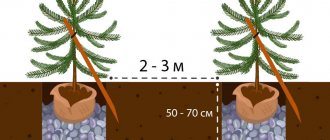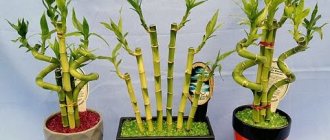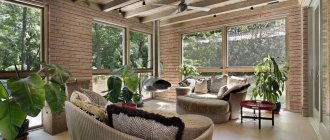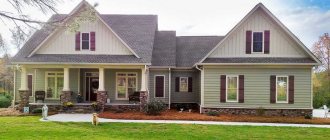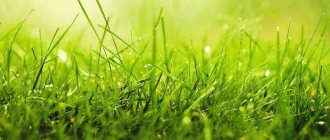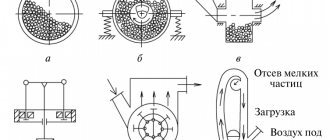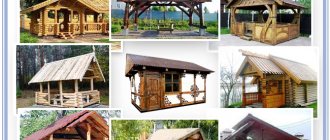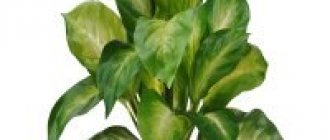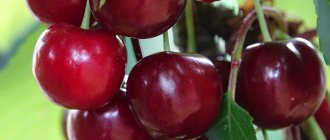Dwarf spruce trees: features and nuances of species
Dwarf spruces are those that are the smallest of their species. You should not assume that they are very tiny and ten centimeters in size, they are simply significantly smaller than their relatives. A dwarf variety means that the spruce has indicators that are significantly lower, approximately 2-3 times, than the classic representative of such spruce. There is another criterion for belonging specifically to dwarfism - below human height. The spreading nature of the plant is measured by the arm span. It is these criteria that are more relevant to dwarfism of Christmas trees. The popularity of the dwarf versions is so great that every year breeders add to the collection.
Features of growing low-growing varieties of conifers
Small forms of conifers have growing rules that are common to all species. Planting is carried out at the end of April or beginning of May, depending on climatic conditions. Usually, dwarf forms of seedlings are purchased in specialized stores, and care must be taken to ensure that the quality of the material is high. The main thing is to check the integrity of the earthen coma; it must be at least ⅓ of the entire seedling, otherwise the plant may not take root. It is worth paying attention to the rich color of the conifer needles and their elasticity; these indicators indicate the good quality of the seedling.
Landing is carried out in this way:
- the hole should be slightly larger than a clod of earth;
- a mound is poured in the center, reaching ⅔ of the height of the pit;
- a conifer seedling is placed on the top of the embankment, and the roots are carefully spread along its slopes;
- then the plant is buried, simultaneously compacting the soil;
- the seedling is well watered;
- dry soil should be poured around the trunk;
- The final stage of planting is mulching the soil with peat.
Caring for dwarf conifers involves watering, sanitary and, if necessary, decorative pruning. In winter, it is worth removing excess snow so that it does not break thin branches and trunk.
Basically, dwarf conifers are susceptible to the following diseases:
- Brown schutte is a very common disease; it is a fungus that mainly affects young specimens. The needles become brown and covered with a gray-black coating. It is treated with preparations containing copper and fungicides.
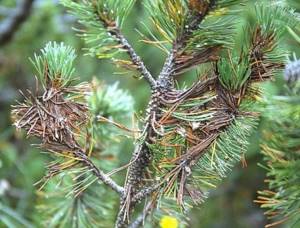
- Rust - fungus causes orange spots to appear, which then turn into brown growths. Slow down the growth and development of the tree. Drugs such as Fitosporin-M and Abiga-Pik are used.
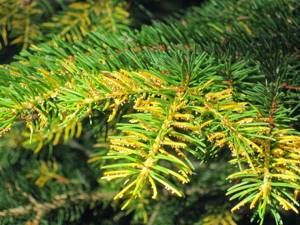
- Gray mold or rot - gray mycelium appears on the needles. Fungicides are effective against it.

- Fusarium - a fungus that causes the plant to dry out. The needles begin to turn yellow, become rough to the touch and fall off. The whole plant gradually dries out. It is almost impossible to cure a tree; Fundazol is used for prevention.
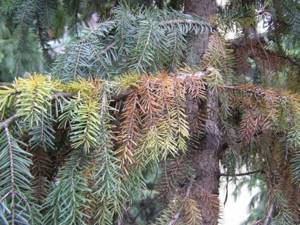
Pests of small forms of conifers include:
- Bark beetle - lives under the bark, making many moves there. They live mainly in forest plantations and can spread from there to a summer cottage. The insect selects weak trees that die as a result of such an invasion. They fight the pest with the help of special preparations.

- Sawfly - under this name many insects are united, attacking mainly spruce and pine. Pests eat shoots that dry out and break. They get rid of them using special preparations or an ash solution.

- Hermes are parasitic insects that drink plant sap. Seals form on the tree, branches are also deformed, and buds are destroyed. The method of control is insecticides.

- Scale insects - attack dwarf thujas, yews and junipers. The needles turn brown, then turn yellow and fly off. The tree becomes weaker and dies. Insecticidal preparations are effective against scale insects. Onion peel is suitable as a folk remedy.
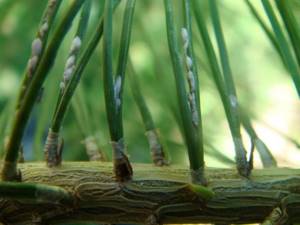
Varieties of dwarf spruce trees
Despite the clear definition of dwarfism in spruce trees, there is a certain gradation of these conifers, which helps to understand whether you are growing it or not. It all depends on the annual growth. Therefore, we can divide all dwarf representatives into groups:
- microdwarf spruce trees are those that during the growing season grow only a couple of centimeters, maximum 3;
- mini-dwarf spruce trees are conifers that increase the ground part by 3-8 cm per year of growth;
- dwarf spruce trees grow up to a maximum of 15 cm per year.
Of course, these data are approximate, so you shouldn’t check them strictly with a ruler.
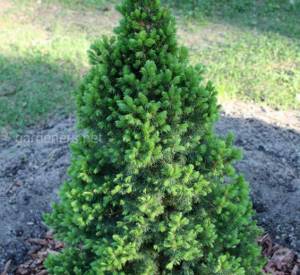
The smallest coniferous trees for small summer cottages
The smallest coniferous trees for small summer cottages
Let’s immediately define what we mean by the concept of “the smallest coniferous trees.” They are dwarf plants, abnormally short and compact for the species.
Despite the accuracy of this definition, it is not an axiom. So, if a coniferous tree reaches a height of 10 m instead of the required 20 m, it still cannot be called a dwarf. Therefore, dendrologists suggest measuring dwarfism relative to human height: true dwarf arboreal conifers remain in adulthood (at 30-50 years) no taller than human height and no wider than the arm span (this applies to prostrate forms).
Tall fir (Abies procera 'Glauca Prostrata')
Recently, dwarf forms of tree conifers are at the peak of their popularity. True lovers of such plants turn into real collectors, annually replenishing their collections with miniature copies of firs, spruces, pines, and larches.
Wide selection of conifers at the exhibition
Despite their rather general definition, dwarf plants are very diverse. Dutch dendrologists, who have succeeded in growing these forms, propose conditionally dividing them into the following groups.
Strengths of dwarf spruce trees
Dwarf representatives of conifers are considered very attractive and the pricing policy is not inferior to the classic version. At the same time, we can highlight a number of advantages and strengths of growing dwarf spruce trees on the site.
- One on one with the original. Despite its dwarfism and compact size, the spruce has an identical structure to the classic version.
- Compact in placement. Dwarf spruce trees can fit into any landscape design and will be appropriately combined with the area, since they take up minimal space. WITH
- Stable composition. The advantage of dwarf versions is that you can foresee the landscape design in the coming years, nothing will change dramatically, so it will have its original appearance.
- Fits well into rockeries, rock gardens and rock slides. Spruce harmonizes well with stone, so it will combine beautifully in an unusual landscape.
- Versatility - for garden and indoors. Dwarf versions of fir trees can not only transform areas, but also become a New Year's beauty if they are fragrant in a container.
- Successful wintering. Dwarf spruces tolerate winters without problems, especially with heavy snow.
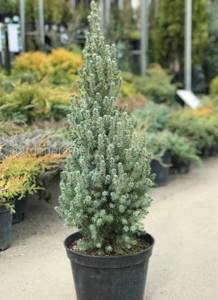
Description of eastern spruce
Eastern spruce - (P. orientalis) - a tree 35–40 m high, a trunk up to 2 m in diameter, lives up to 400 years. The crown is conical. The bark is brown, scaly, dark gray in old trees. The shoots are reddish, yellow-gray, densely pubescent. The needles are small, only 4–8 mm long, hard, prickly, dark green, shiny, flattened and tetrahedral, located along the shoot. The buds are up to 5 mm long, without a resinous coating, and have a reddish tint. The cones are fusiform-cylindrical, 5–10 cm long, 2 cm wide. At first they have a purple color, which then changes to grayish.
Look at the photo - the eastern spruce has black seeds in cones, equipped with a long orange wing:
The western part of the Caucasus, in the mountains from 1350 to 2100 m above sea level, in Turkey rises to 2200 m. It forms pure forests or grows together with fir, beech and hornbeam. In Europe since 1837, it is recommended for cultivation from the forest-steppe zone to the south.
Eastern spruce grows slowly, but is shade-tolerant, unpretentious to soil conditions, and relatively moisture-loving. It can grow on fairly dry thin soils, on rocks, and scattered stones. Lives up to 400–500 years. Suitable for planting on most types of soil we have. Low winter hardiness, in Moscow it freezes heavily.
Since eastern spruce is quite sensitive to drought and frost, it is better to plant trees in a group. And since this tree is large, it is better to plant it in a large open area. Active growth begins after 20 years, when every year the spruce will add up to 20 cm in height. To prevent the young tree from freezing after the final transplant, it must be covered for the winter with spruce branches or craft paper for several years before final adaptation. During dry summers, eastern spruce requires regular watering to prevent the soil from drying out. Even mature trees may require good watering at this time.
Propagation by seeds. An attempt at propagation by summer cuttings was unsuccessful.
Graceful with a narrow conical crown, thin branches and very short needles. Can be planted solo, in groups and in alleys. This type of spruce has given many forms suitable for decorative cultivation: drooping (f. nutans) - with drooping branches; low (f. nana) - a bush with a wide cone-shaped or rounded crown, which is made up of whitish or light brown branches. Dark green needles are arranged in a ring around the branches.
Ten best dwarf spruce varieties
- Dwarf spruce variety "Sanders Blue". This variety is represented by a very small size, as well as a cone-shaped plant. This variety has a unique feature - an attractive color with a blue tint. The parameters of this dwarf representative are minimal, since the growth is no more than 7 cm per year, so after a decade you should not count on huge data; this beauty grows up to 80 cm. The maximum parameters of this variety are approximately 2-3 meters, but such a height can be expected after several decades of growing season, no less. The shoots are located very tightly to the trunk, so the conical shape is represented by a knocked down appearance. The advantage of this variety is that spring burns cause minimal damage to the spruce. This variety likes to grow in sunny areas; shade is welcome only in a minimal amount. As for watering, it needs to be over-watered or create stagnation - this is unacceptable for a successful growing season. This variety looks quite presentable on its own or as an element of a mass composition.
- Dwarf spruce variety "Alberta Globe".This dwarf representative is considered a dense shrub that has needles located in a cushion-shaped structure. The average parameters of this dwarf are 50-80 cm in height. This height is considered maximum, because at the age of ten years the plant barely reaches half a meter. This phenomenon is possible due to an increase of 2-3 cm over the whole year. Despite its compact height, the spreading nature of the conifer is impressive, as it can reach a meter in diameter. The structure of this spruce is special, since the shoots are very short, the needles are soft, not thick, have a light green tint and a needle-like structure. This variety prefers to grow on a nutrient medium with moderate acidity, as well as in the most illuminated area. Overwatering is considered an unfavorable condition for growing. This variety of dwarf spruce will grow without problems in containers and other containers.
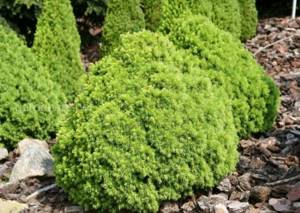
- Dwarf spruce variety "Conica". This dwarf representative has a cone-shaped shape, so it looks very attractive. The parameters of this tree can reach a maximum height of 3 meters, but the diameter of the crown is 2 meters. Spruce grows very slowly, as it grows by only 8-10 cm per year. The advantage of this variety is its thick crown, which has many soft needles, as well as a pleasant light green color of the needles. This variety is popular for its versatility in planting, as it successfully smells not only on a flat surface, but also near landscape design elements - rockeries, rock gardens and other structures. The correct crown features give the plant charm, luxury and popularity.
- Dwarf spruce variety "Bialobok".This representative is considered very compact and slow growing, so it is suitable for any design and use. The crown has an unusual hemispherical shape, as well as an insignificant increase in intensity. During the first decade, the size of this spruce cannot exceed the mark of two meters, although after another decade the intensive activity passes, and the spruce slows down its development at around 3 meters. There is no clear specificity regarding the shape of the crown, since you can find this variety in the form of a cone, a wide cone, or even asymmetry. The needles of this plant are not simple, they are quite hard and prickly. The length of the needles can be only a few centimeters. The advantage of this variety is its original color, blue and silver. During the growing season, you can observe compact cones that barely exceed 5-8 cm. Young shoots have an unusual color - a mixture of cream and yellow, so in the spring the spruce looks fantastic, just like the shades in the sun.
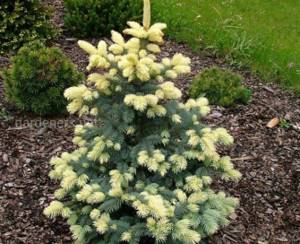
- Dwarf spruce variety "Glauca Globosa". This is a dwarf version, as the height can reach approximately 2-3 meters. This height is maximum and is possible after decades of growth, since the annual growth of needles is approximately 8 cm. The crown has variations depending on the “age”, the younger the plant, the looser the crown, and with age it acquires a spherical shape, which is quite dense . This type of spruce has original elongated cones that hang slightly and are brown in color. The color of the needles itself is a mixture of blue and silver. The cones tend to fall off completely this year. The plant has a modest list of requirements, since the composition of the soil is not important, and temperature changes are not a hindrance, because this coniferous representative is frost-resistant.
- Dwarf spruce variety "Will's Zwerg".This coniferous representative has an unusual narrow crown that resembles a column. It is believed that this spruce grows in the form of shrubs. The growth parameters are very modest, since after the first decade this conifer is barely able to exceed the mark of a meter in height, and the width is 50-60 cm. The structure of the plant is more classic - the shoots are rigid, but the size of the needles is very small, and the color is rich dark -Green colour. In spring, you can clearly notice the annual growth, since the color of the young shoots is green with a yellowish tint. This spruce can grow successfully in more shady areas and modest properties, as it does not require a large plot. Dry air is not an obstacle to full development.
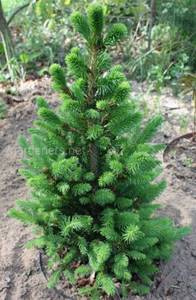
- Dwarf spruce variety "Echiniformis". The French presented this dwarf beauty to the whole world. This version of spruce is truly the most minimal, since the height is not just small, but very miniature. Scientists say that after thirty years of growing season, you can only count on half a meter in height, but the diameter of the crown can reach a meter. The shoots are small and only a couple of centimeters long. The needles are also very modest in size, up to 7 mm. The color of the miniature spruce is very attractive, as there is a slight blue tint against the green background. The ideal growing environment is soil that is weak in acidity. Prefers damp areas, as well as a sufficient amount of light. It overwinters without problems, but if the weather is without snow, then it is advisable to cover the plantings of this spruce variety.
- Dwarf spruce variety "Nidiformis".This is a striking representative of dwarf spruce trees, which has an unusual cushion-shaped crown, as well as a significant depression closer to the middle, so many associate the principle of growth with the formation of a nest. The parameters are very modest, since after the first decade of growing season the plant often reaches 40 cm, and a height of a meter is a certain maximum. The unusual structure of the crown is quite understandable, since the shoots have a direction of growth to the side, but there are simply no main branches inside. Despite the original structure, there are a huge number of branches, so the density is good. The greens are rich and dark. The length of each needle is no more than a centimeter. Every year the plant grows by only 3-4 cm, and its width increases by 7-8 cm. This dwarf variety does not care about the soil, but the amount of watering should not exceed the average norm. It looks good not only in single plantings, but also in mass plantings, and is an attractive member of large groups.

- Dwarf spruce variety "Daisy White" (Dejzi Uajt). This is a compact cone-shaped representative that has fairly soft needles of an attractive rich green color. A special feature of the variety is its light growth of unusual color, where yellow and white are mixed, which can be observed in early summer. Next, the growth begins to change color to a greener one. The parameters of this spruce are very modest, since in ten years it can reach only 80 cm. The maximum height of the variety does not exceed 2-3 meters. This beauty can grow not only in a sunny area, but also with periodic shade. The soil should be fairly fertile and have a good drainage system. The acidity level should not be high. This beauty can be planted in any convenient place, near rockeries and rock gardens.
- Dwarf spruce variety "Lucky Strike". This representative has a beautiful conical crown shape and rather slow growth. After a decade of growing season, you can count on a plant that will barely exceed a meter. An adult plant reaches a height of no more than two meters. The needles have an attractive appearance, not too long, only a couple of centimeters in length, have a beautiful green color and a pleasant sheen. The growth is very small, has a light color, where green and yellow are combined. During the growing season, you can observe the presence of small cones that can reach a length of 15 cm. The color of the cones is light brown, they look good in the general mass of spruce. It is advisable to plant this variety in a well-lit place where there is nutritious soil with an excellent drainage system, since stagnation of moisture is strictly prohibited. It overwinters successfully and decorates any area.
Dwarf spruce trees are an excellent alternative to massive tall representatives. It takes up minimal space on the site, but gives the landscape design no less decorative value.
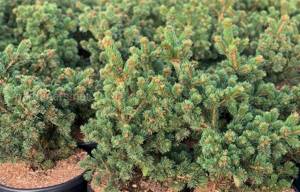
Features of care
Blue spruce grows actively in a sunny garden plot, but some varieties can grow in partial shade. Once you have planted a tree, it needs to be watered about once a week. It is better if watering occurs once, but deeply, than to water the tree 2 times a week, but not too deeply. Although spruce trees like moist soil, they are also drought tolerant, so to prevent rapid evaporation of moisture, simply sprinkle mulch over the root zone. This can be wood chips, sawdust, pine needles, and other materials.

Find out what blue spruce diseases are.
If you notice yellow needles or spider webs, treat the tree with an insecticidal spray. Other insects cause minimal damage. The popularity of blue spruces not only does not decrease, but is also growing every year, therefore, when choosing a tree to plant, be guided by the shape of its crown and the needs of your landscape. With a little care, the spruce will definitely delight you with its beautiful appearance not only in winter, but also in summer.

